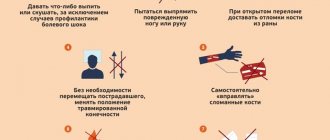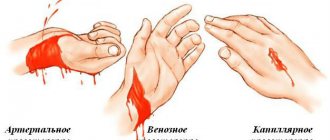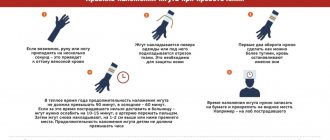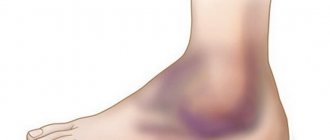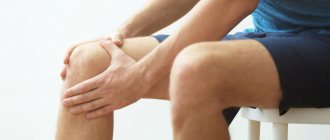A fracture is a bone injury that disrupts its integrity. Traumatic fractures are divided into open (there is damage to the skin in the fracture area) and closed (the skin is not broken).
With an open fracture, the injury is beyond doubt. A closed fracture is not so obvious, especially if it is incomplete, when part of the diameter of the bone is broken, often in the form of a crack.
All fractures are characterized by:
- sharp pain with any movements and loads;
- change in the position and shape of the limb, its shortening;
- dysfunction of a limb (impossibility of usual actions or abnormal mobility);
- swelling and bruising in the fracture area.
Providing first aid for fractures of the extremities largely determines the outcome of the injury: the speed of healing, the prevention of a number of complications (bleeding, displacement of fragments, shock) and has three goals:
- creating immobility of bones in the fracture area (which prevents displacement of fragments and damage to them by the edges of blood vessels, nerves and muscles);
- prevention of shock;
- prompt delivery of the victim to a medical facility.
First aid for a closed fracture
If it is possible to call an ambulance, then do so. Then keep the injured limb immobile, for example, place it on a pillow and keep it at rest. Place something cold on the suspected fracture area. The victim himself can be given hot tea or a painkiller to drink.
If you have to transport the victim yourself, you must first apply a splint from any available materials (boards, skis, sticks, rods, umbrellas).
Any two solid objects are applied to the limb from opposite sides on top of clothing and secured securely, but not tightly (so as not to interfere with blood circulation) with a bandage or other suitable materials at hand (sash, belt, tape, rope).
It is necessary to fix two joints - above and below the fracture site. For example, in case of a tibia fracture, the ankle and knee joints are fixed, and in case of a hip fracture, all joints of the leg are fixed.
If there is absolutely nothing at hand, then the damaged limb should be bandaged to the healthy one (arm to the body, leg to the second leg).
A victim with a broken leg is transported in a lying position; it is advisable to elevate the injured limb.
Symptoms of a fracture
All symptoms of a closed fracture can be divided into absolute and relative.
The following are considered absolute characteristics:
- unnatural mobility in the damaged area;
- deformation of the limb, which may be absent if there is no displacement of bone fragments;
- crepitus (crunching sensation when palpating the site of injury).
Relative features are:
- pain that can cause painful shock;
- limitation of limb mobility;
- increasing swelling;
- hematoma.
Diagnosis of a closed fracture
A closed fracture is more difficult to diagnose compared to an open one. The main research method is radiography in two or more projections including at least one joint. In addition, the following are used:
- computed tomography to study the condition of bone structures;
- magnetic resonance imaging to study soft tissues;
- arthroscopy and ultrasound to study intra-articular injuries.
To assess the severity of the condition, it may be necessary to consult a neurologist or neurosurgeon, an abdominal surgeon (if the pelvic bones are damaged), or a vascular surgeon. All these difficult diagnostic stages are available in modern medical science.
First aid
Independent attempts to reduce bone fragments are unacceptable. This threatens the occurrence of painful shock, dangerous additional injury to surrounding tissues and increased blood loss. The correct algorithm of actions is as follows:
- Give a pain reliever.
- Immobilize with reliable fixation - not only the injured area, but also the two joints on the sides of the injury site. Fixation of a leg fracture is carried out using a special splint, a light board or a straight stick. The arm is fixed with a special orthosis, a scarf made of thick fabric or a bandage, which is secured to the neck. If the spine is damaged, the victim is placed on a hard, flat surface.
- Call an ambulance or independently, without disturbing the immobility of the damaged area, deliver the victim to a medical facility.
Arm fracture - general information
Damage of this type is directly related to bone deformation, which can occur in any part of the upper limb, from the shoulder to the flanks of the fingers. According to medical statistics, the most commonly fractured bones are the third radius, the wrist, the neck of the humerus, and the fingers.
The reason for the violation of the integrity of the bone can be a fall, a blow, or a strong mechanical load (for example, some heavy object falls on the hand). It makes perfect sense that as a person ages, bones become brittle and the risk of a fracture increases significantly. There are a number of diseases that lead to a decrease in bone strength, namely:
- osteoporosis;
- cyst;
- osteomyelitis;
- malignant and benign tumors.
Classification
Bone damage comes in different forms, in different locations, and varies in severity. Modern medicine distinguishes the following categories:
- Type of fracture – closed, open (without or with a rupture of the skin, respectively).
- Location - on the bone itself (diaphyseal), near its end (metaphyseal) and at the very end (epiphyseal).
- Shape – longitudinal, transverse, screw-shaped, star-shaped, V- and T-shaped, crushed and splintered.
- The number of affected areas is one (only one bone is affected, which means an isolated type), two or more (multiple type).
- Fragments - cause displacement or not. The displacement itself also differs in its width, length and angle of inclination (it can be primary, if it occurs from a heavy load, and secondary, if caused by a muscle reaction).
First aid for a stroke before the ambulance arrives
At home, you can carry out a set of measures to support the patient, but in any case you cannot do without professional doctors. If blood pressure rises, it does not need to be lowered; this is an adaptive reaction of the body. Thus, the body tries to improve blood supply to the brain through special “backup pathways” of blood circulation - collaterals. You should not give the patient any medications because you do not know whether the patient has a stroke or other illness. In addition, ischemic and hemorrhagic strokes are treated completely differently. It is the doctors’ task to make a diagnosis within 3 hours, deliver to a specialized center for the treatment of stroke and prescribe appropriate treatment. It is important to understand that nerve cells die within 5 minutes if they do not receive sufficient blood supply. Therefore, the infarction zone can no longer be saved, but around the zone of cell death a border region is formed (the so-called “penumbra” - penumbra), where nerve cells are on the verge of death. If left untreated, the penumbra area increases and more and more cells die, which is manifested by worsening stroke symptoms and a poor prognosis for life and subsequent recovery.
Self-help for stroke
If the symptoms are minor and the victim remains conscious and able to move, he can administer first aid to himself. But only after an ambulance is called. In case of a stroke it is worth:
- Tell someone other than your doctors that you feel unwell. Call neighbors and relatives who are nearby.
- Take a horizontal position with your head raised or in a position lying on your side.
- Free your neck and chest from constricting jewelry, shirt collars, ties, and other clothing.
- Do not get up until the ambulance arrives.
Treatment
As you know, there are two methods of treatment - conservative and surgical. The first method is suitable for a closed type of injury, without fragments or significant damage to adjacent areas. The patient is placed in a plaster cast and prescribed a course of medications (painkillers, restoratives, calcium-containing). Depending on the severity of the damage, the time of wearing the cast varies from 3 to 10 weeks.
The presence of fragments or severe open fractures require surgical intervention and reduction. The individual parts of the bone are attached using special knitting needles, bolts and plate-shaped joints. At the final stages, cosmetic stitches are applied and a rehabilitation course is developed.
Symptoms
In some cases, a fracture of the arm can be diagnosed after a visual examination (the joint is too loose, the bone sticks out or is significantly bent in the direction opposite to the movement, a crunching sound is heard when moving). An open fracture is characterized by bleeding, damage to the skin and visibility of the bone.
The closed type of injury can be without displacement (the position of the bone remains normal). This situation requires a qualified examination in order to accurately determine the nature of the injury and not confuse it with a bruise or dislocation. Other symptoms:
- sharp and sharp pain sensations transmitted to other parts of the body;
- swelling of large diameter;
- blue skin;
- the arm may become shorter;
- a feeling of cold a little further from the site of injury;
- low mobility or its complete absence.
The diagnosis is confirmed after an x-ray.
Rehabilitation
Includes:
- physiotherapeutic procedures - magnetic therapy, laser, light and ultrasound irradiation, as well as electrophoresis;
- gymnastics – gradual development of the arm, selection of a set of exercises, daily increase in load under the supervision of a rehabilitation physician;
- massages - to improve blood flow, restore muscle and ligament fibers.
Additionally attributed: mud baths, paraffin therapy, compresses, soaking in sea salt or decoctions of medicinal herbs.
What should not be done for bruises and fractures?
Firstly, you cannot ignore the injury you have received and not take the necessary measures, even if outwardly the injury may seem minor. Only a doctor who takes an x-ray can determine the severity and type of injury.
Secondly, it is impossible to transport the victim without fixing the injured limb.
Thirdly, do not try to put the injured arm or leg back in place yourself , this will only worsen the situation.
Fourthly, for bruises and fractures, do not use painkillers without consulting a doctor.
Limb fractures. Symptoms of limb fracture. First aid for broken limbs
Home / Useful information
Fractures of the bones of the extremities are one of the most common types of fractures, which are usually the result of minor domestic trauma and are observed more often in older people due to decreased elasticity of the bones, although fractures of the extremities can also occur in children, young and middle-aged people, however, in this case they are usually associated with a fairly strong mechanical effect on the bone.
The majority of extremity fractures are fractures of the radius in a typical location, fractures of the tibia, fractures of the humerus in the surgical neck area, and fractures of the femoral neck.
Causes of fractured limb bones
Most limb fractures are the result of trauma. Moreover, typical ways of getting injured in everyday life - falling on the hand, on the shoulder, and so on - lead to fractures in the typical - weakest places of the bone.
However, it is worth mentioning separately about other causes of limb fractures, in particular, so-called pathological fractures. They can be observed in cases of cancer, taking certain drugs that reduce bone density, and so on. Such fractures can occur even without seemingly significant trauma.
Despite the fact that pathological fractures are usually a consequence of another, more serious pathology, they still require emergency care and hospitalization in a specialized department. Therefore, if any person has the first symptoms of injury, it is necessary to immediately call an ambulance.
!!! It is worth remembering that a fracture of a limb can cause serious complications, in particular pain shock, so specialized care should always be provided as early as possible.
Symptoms of limb fracture
In order to suspect the presence of a bone fracture in time and call an ambulance , you need to know the main symptoms of a broken limb, these include:
1. Pain. It can be very pronounced, and its epicenter is at the site of the fracture. It should be remembered that pain can be observed with a bruise, but its intensity is greatest precisely with fractures, which is dangerous due to the development of traumatic shock, and therefore an emergency medical team should be called immediately in this case.
2. Swelling and swelling. At the site of the fracture, a pronounced swelling occurs, which is associated with damage to the soft tissues and the development of inflammation in them. Often the cause of swelling can be a hematoma - an accumulation of blood in the tissues. The latter may indicate damage to the vessel and the development of bleeding. Bleeding is one of the most dangerous complications, as it can cause the development of hemorrhagic shock.
3. Deformation of the limb and disruption of its function, as a rule, are associated with displacement of bone fragments, and therefore the limb itself can be shortened or deformed in another way, and movements can be limited both in a certain plane and actually reduced to a minimum, which depends on the nature of the location of the fragments and the location of the bone fracture.
4. Crepitation upon palpation (feeling). Crepitation is a characteristic crunching sound that is formed as a result of friction between bone fragments. A similar symptom of a fracture of the limbs is observed with a displaced fracture.
It should be noted that limb fractures can be open (with skin damage) or closed (without skin damage). If the fracture is open, bone fragments may be visible in the wound. In this case, other symptoms of a limb fracture fade into the background, and the diagnosis turns out to be extremely simple.
But it is worth considering that it is in this case that the patient’s psychological state turns out to be extremely unstable, which means that an ambulance should be called as early as possible, and its quick arrival at the scene will ensure not only the provision of proper assistance in connection with the fracture by medical workers, but also stabilization psychological state of the patient.
Diagnosis of limb fracture
In the case of open fractures with bone fragments visible in the wound, diagnosis is not difficult. In case of closed limb fractures, the diagnosis is confirmed by X-ray examination.
It is worth saying that in any case, diagnosing limb fractures does not present much difficulty. Much more important is the diagnosis of complications, in particular, internal bleeding, the presence of nerve damage, the development of shock (hemorrhagic, painful), and so on.
That is why it is important not only to conduct additional research, but also to qualitatively examine the patient, make sure his condition is stable or understand that there are life-threatening complications.
private ambulance doctors are highly qualified medical personnel who have not only the necessary knowledge, but also extensive experience, and our teams are equipped with all the necessary equipment. Therefore, when turning to us for help, you can be sure that the patient will receive fast, qualified and complete pre-hospital care, and will also be transported to a specialized hospital as soon as possible.
First aid for broken limbs
Fractures of the bones of the extremities, as a rule, are not associated with dysfunction of vital organs and systems, so patients do not need to give them a special position and carry out specific measures, for example, cardiopulmonary resuscitation, which are often required for more serious injuries accompanied by the development of cardiac -pulmonary insufficiency.
First aid should be:
- providing access to fresh air
- psychological support and, if possible, reassurance of the patient
— call an ambulance as quickly as possible
Specific assistance, in particular:
- immobilization
- pain relief
- application of aseptic dressing
- primary bleeding control can only be performed by specialists.
Therefore, both the patient’s condition and the prognosis depend on the speed of arrival of the ambulance and the provision of appropriate assistance.
Don’t hesitate and hope for a “miracle”, seek medical help immediately, and our private ambulance service is always ready to provide you with high-quality services - quickly and professionally!
